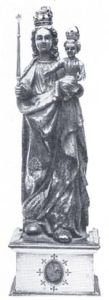Our Lady of York
Our Lady of York
Q: Who is Our Lady of York?
A: Our Lady of York, Mother of Mercy, in St. Wilfrid's Church, is not of English origin. The statue comes from Flanders. Here is what tradition tells us about the history of Our Lady of York.
The History of Our Lady of York
There had stood, far away on the other side of the North Sea, a wayside shrine beside the road from Moorseele to Menin in Flanders, wherein was a venerable statue of Our Lady under the title of Mother of Mercy and Our Lady of the Ramparts. Although the statue had stood there from "time immemorial," in 1687 the Dominican Friars of Menin applied to the Bishop of Tournai for permission to remove it to a new shrine within Menin itself.
The Fathers built a new chapel, and the townsfolk a convent, for the Dominican nuns who were to be custodians. The shrine was to be open at all hours of daylight, and Masses were to be offered there for the benefit of both townsfolk and pilgrims. Each year the Feast of the Assumption was to be kept with solemnity at the shrine, with high mass, which was to be followed by a special novena of prayer and pilgrimage. It is known that the new shrine became highly popular.
A century later, 1797-98, the fierce tide of the French Revolution swept over Menin. The convent was suppressed and the shrine destroyed, but the nuns escaped and managed to save the holy image. Some years later they were able to return to the town, where they made a chapel in honour of the Mother of Mercy in the best room of their private house. But the community languished and eventually died out.
The statue then passed into the keeping of the Chaplain, Father Rembry, a Capuchin who had formerly been Guardian of the Menin Greyfriars. He hoped to see the day when a proper shrine might be re-established but various suggestions came to nought and, at last, realizing that his end was near, the Father entrusted the statue to his niece, Mme Vandepitte, who in turn bequeathed it to her son, Father Richard Vandepitte, in 1869.
At this time, Father Vandepitte was working in the parish of Our Lady of Victories in Market Harborough. His first reaction was to make a new shrine at his own church, and to that end he built the beautiful Lady Chapel close to the high altar there. But in those days Market Harborough was isolated and it became evident that devotion to the Mother of Mercy was unlikely to flourish as he hoped in so small a town.
Father William Browne, formerly Vicar General of the Diocese of Nottingham, had lately become parish priest of St. Wilfrid's, York, the church which stands immediately in front of the western façade of the Minster. He it was who suggested that Father Vandepitte might find York, with its vast interjunction of railways, a better center of pilgrimage.
It was to discuss this plan that Father Vandepitte had come to York, when he discovered the prophetic inscription in the Minster. He hastened to tell Father Browne of his determination, that the shrine should be near to the Minster as possible, to be met with the spontaneous invitation to erect the shrine within St. Wilfrid's.
Until 1878 this church had provided the Chapter Room for the former Diocese of Beverly, erected in 1850 on the Restoration of the Catholic Hierarchy. But by 1883, the newly formed Diocese of Middlesbrough had its own cathedral and the Chapter Room at St. Wilfrid's served no really useful purpose.
Built at the "western" end of the nave, it was like a little church apart from the rest, and ideal for the purpose suggested. As soon as he had verified the authenticity of Fr. Vandepitte's statue, Bishop Lacy of Middlesbrough welcomed the plan, and Bishop Bagshawe, of Nottingham, gave his willing, if sad, consent to the removal of the statue from Market Harborough.
The translation took place on January 10, 1884. The chapter room had been furnished at no small expense as a chapel for the new shrine. Bishop Lacy sang the high mass which was attended by a distinguished congregation. Afterwards the venerable Father Vandepitte bore the statue in his own hands and set it beneath a canopy behind the altar in the new Lady Chapel.
The Statue of Our Lady, Mother of Mercy

The statue, 19 ½ inches tall on a pedestal of 5 ½ inches, is made of two blocks of wood, of different timbers. The lower block, which includes the base, is apparently somewhat older than the upper. Its carving is somewhat more archaic, whereas the upper section has been treated with exceptional skill and dignity. A date, which may never be explained, 1627, has been carved on the lower part.
Our Lady’s under-robe is dull red, covered with a mantle of blue, shot with a bold diaper pattern in faded gold. Our Lord’s tunic is red, varied with gold. Both figures wear crowns of silver gilt and carry exquisite small sceptres, perfectly proportioned.
When these were cleaned and mended in 1943, it proved impossible to assign an exact date to them, other than that they are hundreds of years old. They may have been presented to the statue, in honour of Our Lady and the Holy Child, at its translation to Menin in 1688, but the probability is that they are even older.
All About Mary includes a variety of content, much of which reflects the expertise, interpretations and opinions of the individual authors and not necessarily of the Marian Library or the University of Dayton. Please share feedback or suggestions with marianlibrary@udayton.edu.
